|
Dynamic
Thermal Management in CMPs
High Performance Computing Laboratory
Chip
Multiprocessors (CMPs) have been prevailing in the modern microprocessor
market. As the significant heat is converted by the ever-increasing power
density and current leakage, the raised operating temperature in a chip
have already threatened the system reliability and led the thermal
control to be one of the most important issues needed to be addressed
immediately in the chip design. Due to the cost and complexity of
designing thermal packaging, many Dynamic Thermal Management (DTM)
schemes have been wildly adopted in the modern processors as a technique
to control CPU power dissipation. However, it is known that the overall
temperature of a CMPs is highly correlated with
temperature of each core in the CMPs environments; hence, the thermal
model for uniprocessor environments cannot be directly applied in CMPs
due to the potential heterogeneity. To our best knowledge, none of prior
DTM schemes considers the thermal correlation effect among neighboring
cores, neither the dynamic workload behaviors which present different
thermal behaviors. We believe that it is necessary to develop an
efficient online workload estimation scheme for DTM to be applicable to
the real world applications which have variable workload behaviors and
different thermal contributions to the increased chip temperature.
Predictive
Dynamic Thermal Management
Recently, processor power density has been increasing at an alarming rate
resulting in high on-chip temperature. Higher temperature increases
current leakage and causes poor re- liability. In this work, we propose a
Predictive Dynamic Thermal Management (PDTM) based on Application-based
Thermal Model (ABTM) and Core-based Thermal Model (CBTM) in the multicore
systems. ABTM predicts future temperature based on the application speci?c thermal be- havior, while CBTM estimates core temperature pattern
by steady state temperature and workload. The accuracy of our prediction
model is 1.6% error in average compared to the model in HybDTM, which has at most 5% error. Based on
predicted temperature from ABTM and CBTM, the pro- posed PDTM can
maintain the system temperature below a desired level by moving the
running application from the possible overheated core to the future
coolest core (migra- tion)
and reducing the processor resources (priority schedul-
ing) within multicore systems. PDTM enables the
explo- ration of the tradeoff between
throughput and fairness in temperature-constrained multicore systems.
We implement PDTM
on Intel's Quad-Core system with a specific device driver to access
Digital Thermal Sensor (DTS). Compared against Linux standard scheduler,
PDTM can decrease av- erage
temperature about 10%, and peak temperature by 5
degrees with negligible impact of performance under 1%, while running
single SPEC2006 benchmark. Moreover, our PDTM outperforms HRTM [10] in
reducing average temperature by about 7% and peak temperature by about 3
degrees with perfor- mance
overhead by 0.15% when running single benchmark.
|
Comparisons between
without DTM and PDTM
|
|
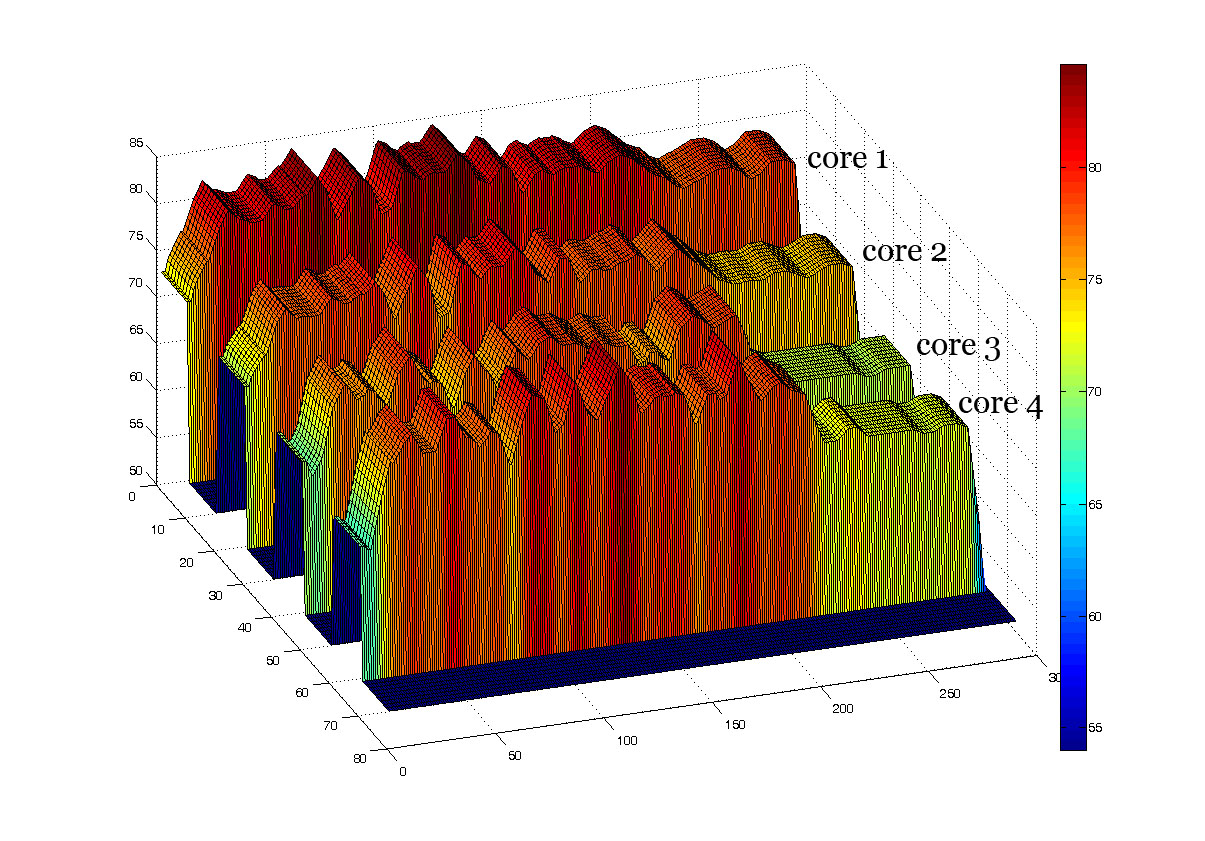
|
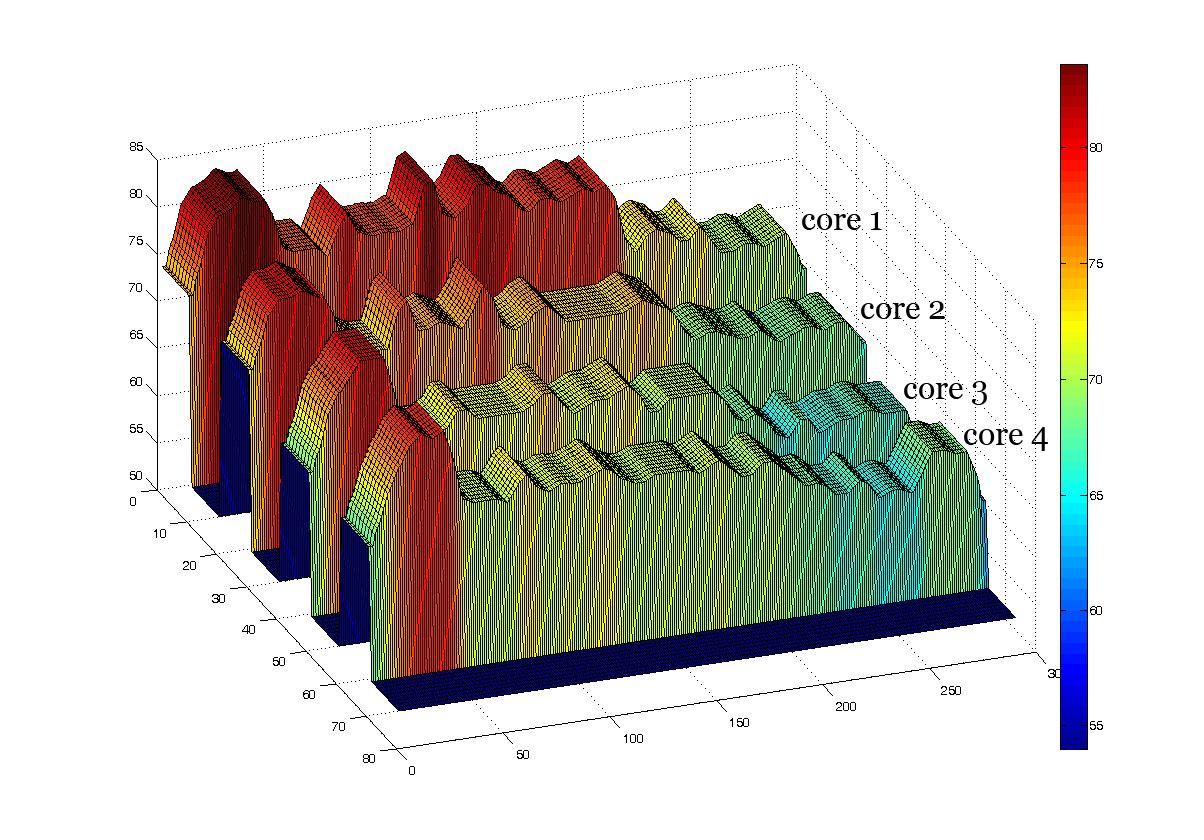
|
|
Without DTM
|
PDTM
|
Hybrid
Dynamic Thermal Management Multimedia applications
become one of the most popular applications in mobile devices such as
wireless phones, PDAs, and laptops. However, typical mobile systems are
not equipped with cooling components, which eventually causes critical
thermal deficiencies. Although many low-power and low-temperature
multimedia playback techniques have been proposed, they failed to provide
QoS (Quality of Service) while controlling
temperature due to the lack of proper understanding of multimedia
applications. We propose Hybrid Dynamic Thermal Management (HDTM) which
exploits thermal characteristics of both multimedia applica-
tions and systems. Specifically, we model
application characteristics as the probability distribution of the number
of cycles required to decode a frame. We also improve existing system
thermal models by considering the effect of workload. This scheme finds an
optimal clock frequency in order to prevent overheating with minimal
performance degradation at runtime.
The
proposed scheme is implemented on Linux in a Pentium- M processor which
provides variable clock frequencies. In or- der to evaluate the performance
of the proposed scheme, we exploit three major codecs, namely MPEG-4,
H.264/AVC and H.264/AVC streaming. Our results show that HDTM lowers the
overall temperature by 15 degrees and the peak temperature by 20 degrees,
while maintaining frame drop ratio under 0.2% compared to previous
thermal management schemes such as feedback control DTM, Frame-based DTM
and GOP-based DTM.
|
Instructions and Frequency
|
|
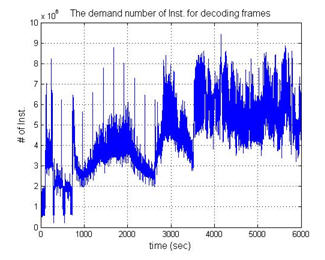
|
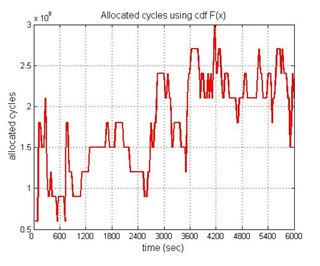
|
|
The
number of instructions
|
The
estimated frequency
|
Correlation-Aware
Thermal Management The overall temperature of a CMPs is highly correlated with temperature of
each core in the CMPs environments; hence, the thermal model for
uniprocessor environments cannot be directly applied in CMPs due to the
potential heterogeneity. To our best knowledge, none of prior DTM schemes
considers the thermal correlation effect among neighboring cores, neither
the dynamic workload behaviors which present different thermal behaviors.
We believe that it is necessary to develop an efficient online workload
estimation scheme for DTM to be applicable to the real world applications
which have variable workload behaviors and different thermal
contributions to the increased chip temperature. In this work, we propose
a light runtime workload estimation using the cumulative distribution
function to observe the processes¡¯ dynamic workload behaviors, and
present a proper thermal model for CMPs systems to analyze the thermal
correlation effect by profiling the thermal impacts from neighboring
cores under the specific workload. Hence, according to the estimated
representative workload and modeled thermal correlation effect, we
estimate each core¡¯s future temperature more accurately with only 2.4%
error in average. Next, Proactive Correlation-Aware Thermal Management (ProCATM) is introduced to avoid thermal emergencies
and provide thermal fairness with negligible performance overhead.
we
implement and evaluate ProCATM in an Intel Quad
Core Q6600 and an Intel Core i7 965 processor systems running grouped
multimedia application and several benchmarks for server environments.
According to the experimental results, ProCATM
reduces the peak temperature by up to 9.09% and 7.94% in our 4-cores
system and 8-cores system with only 2.28% and 0.54% performance overhead
respectively compared to the Linux standard scheduler.
|
Correlation-Aware Thermal Management
|
|
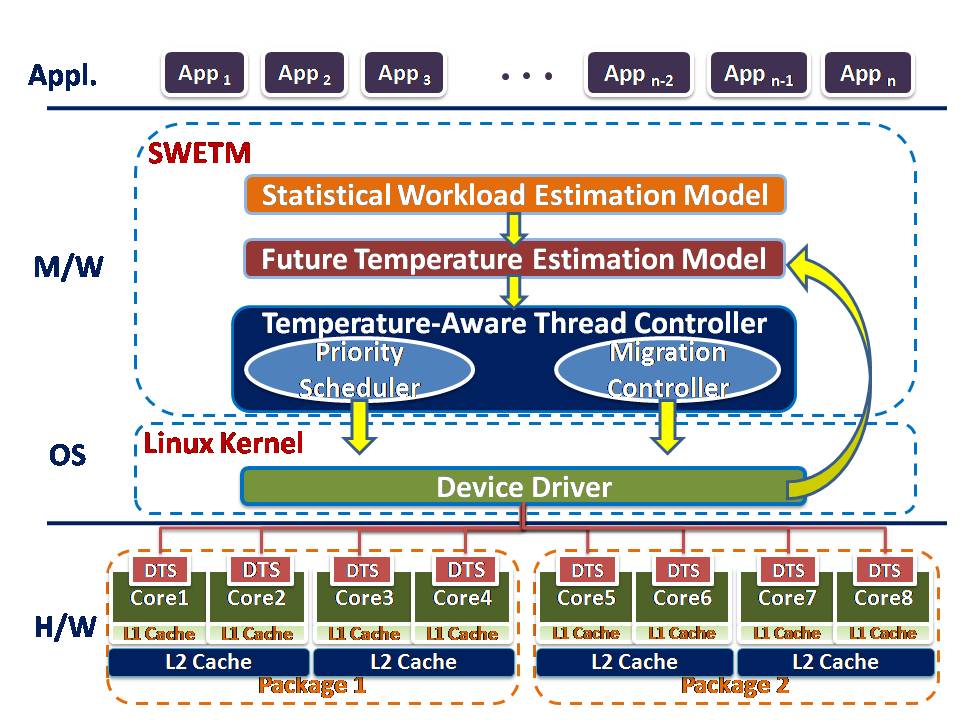
|
|
|
System Overview
|
|
- "Temperature-Aware Scheduler Based on
Thermal Behavior Grouping in Multicore Systems," in Design,
Automation & Test in Europe (DATE 2009), Nice, France, April,
2009.
|